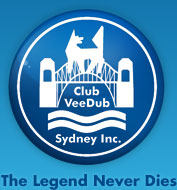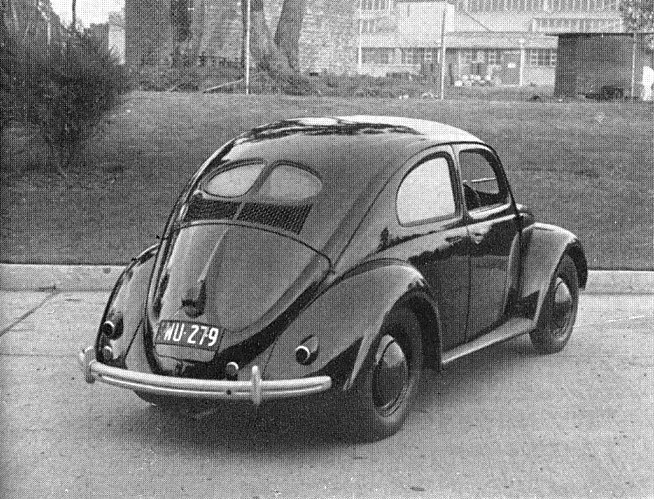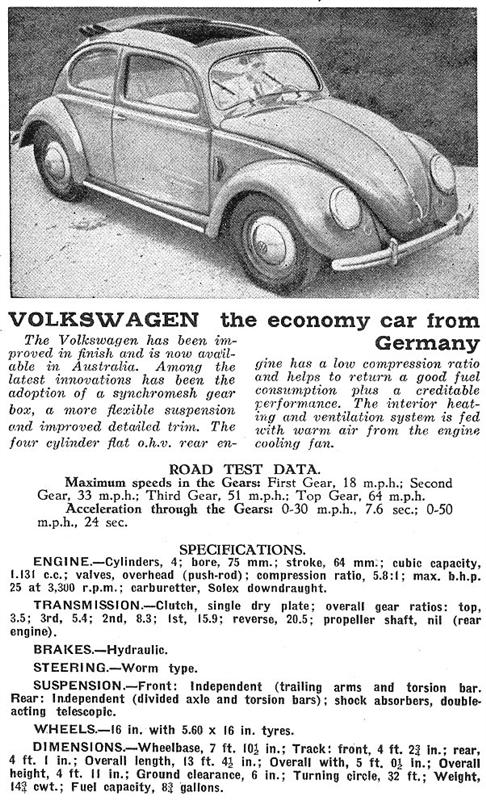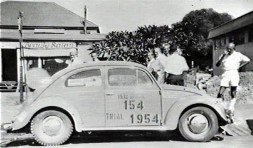1940 - 1954
Australian Volkswagen History
1941-42
Australia is at war. The 6th, 7th and 9th Divisions of the 2nd Australian Imperial Force (AIF) are sent to the Middle East against the Italians and the Germans, while the 8th Division is sent to reinforce Singapore against the advancing Japanese. Australia has 250,000 men serving in the armed forces at this dark time.
In North Africa the Australians are soon fighting the advancing German Afrika Korps under the command of field marshal Erwin Rommel. Four brigades of the 7th and 9th, later known as the legendary ‘Rats of Tobruk’, hold the Libyan port against Rommel’s attacking forces for six months. The 6th and 7th are relieved and shipped home to defend Australia in New Guinea, but the 9th stays. After a year of desert fighting, the British 8th Army and the Aussies win the decisive 1942 battle of El Alamein that finally ended German expansion into Africa. Rommel’s troops are eventually pushed back to Tunisia, and the experienced 9th is sent home.
The diggers of the North African campaign become the first Australians to ever come into contact with the German Volkswagen, as Rommel’s forces used the Kübelwagen as light transport vehicles in the desert campaign. A number of Kübels are captured by Australian soldiers, with some of them used behind the lines by Australian field officers. Unfortunately all of them have to be left behind in the desert when the last Australian forces are withdrawn in early 1943.
Australian soldiers also fought the Vichy French in Syria, but did not serve at all in Western Europe during WW2 (except for Australian airmen in the RAF). They therefore didn’t come into contact with the Volkswagen again. After the victorious African campaign (at a cost of 3,500 Australian lives), the Australian forces spend the rest of the war fighting the Japanese in Malaya, Papua and New Guinea, Bougainville, New Britain, Borneo and Tarakan. They have no further contact with the Germans.
1946
At the end of the war the Australian Army ships the first Volkswagen vehicle to Australia, a wartime Kübelwagen sourced from the British Army in Wolfsburg. The Australian Army remembered how competent the VWs were in North Africa and wanted to evaluate them for possible Australian use. After being tested in local conditions for several months, the Kübel is retained and stored for some years before being donated to the collection of the Australian War Memorial in Canberra. It has since been restored, with paint scheme and accessories appropriate to the North Africa campaign. It can sometimes be seen on display in the North Africa gallery, although the AWM often rotates their huge collection. Check before you visit - www.awm.gov.au
1947
The Australian Scientific and Technical Mission, based at the Embassy in London, applies to the Ministry of Supply to purchase eight Volkswagens. These are intended for use by the Australian Reparations Plant and Stores Team, located in Germany. The VWs' purchase price is £160 each. Six of them stay with the Reparations Team in Germany, while two are shipped out to Australia as 'prototypes for testing purposes' at no charge. The first VW is shipped from Antwerp in March, with second one following in June, and on arrival in Melbourne they are assigned to the Department of Post-War Reconstruction. A large supply of spare parts is included at an additional cost of £340. One of the VWs is a normal 1947 Type 11 Sedan, while the other is a Type 51, a VW Sedan with Kübelwagen running gear.
1948
The British Occupying Forces are preparing to hand the Wolfsburg Motor Works back to the Germans as part of the new Federal Republic of West Germany. After considerable delay, the Australian Government appoints automotive engineer Laurence Hartnett to visit Wolfsburg to determine if any equipment can be secured for Australian use, as war reparations. Hartnett inspects the still war-damaged but recovering factory, and discovers that the desirable Kübelwagen is no longer available – the former body works (Ambi-Budd) are now in the Soviet Sector of Berlin. He examines and rejects the VW Beetle itself, but requests that the VW press shop equipment be shipped to Australia. The British Army rejects the request and the Australians get nothing.
1949
The Department of Post War Reconstruction has no further use for the two Volkswagens, so they are auctioned off by the Commonwealth Disposals Commission at Tottenham in Victoria. A large quantity of Volkswagen spares, many other motor vehicles and a wide range of miscellaneous materials is also auctioned. The VWs are advertised as 1940 models, which was not correct. One of the VWs had 10,000 miles on it and is sold for £470, while the other had just 500 miles and is sold for £580.
One of the VWs has since been lost, but the other one somehow survived the years until eventually found in 1990 on Flinders Island, off Tasmania, by a dedicated group of VW enthusiasts led by Grahame Lees (owner of Brookvale VW Spares, Sydney). It was the Type 51 that was found. The decrepit and semi-complete remains were sent to storage in Sydney, and later put on display. The chassis and bodyshell were later sold and are now in Adelaide, undergoing restoration.
1951
The first privately imported Volkswagen arrives in Australia, a black right-hand drive 1946 model shipped in with arriving German immigrant Therese Hanael. She had purchased the car from a British Officer of the Occupational Forces in Germany just prior to her departure. She arrived by ship from Antwerp with her son (and the VW) to join her husband Ted, who as a German citizen had been interned in Australia during the war. The family decided to spend the rest of their lives in peaceful, prosperous Australia, and settled in Horsham, Victoria. They would use the black 1946 VW for their daily transport for many years, Ted using it to drive to and from his work with the Victorian Electricity Commission. It was the very first Volkswagen to drive freely about on Australian roads.
1952
The boss of Volkswagen’s South African organization, the German-born Baron Klaus von Oertzen, invites his Melbourne-based friend and car distributor, Lionel W. Spencer, to visit Wolfsburg. Von Oertzen and Spencer had worked together selling two-stroke DKWs in Australia before the war, when the Baron worked for Auto Union - the result of a 1932 merger of German car companies DKW, Audi, Horch and Wanderer. The Baron had actually designed the Auto Union logo of four rings, still used today by Audi. The Baron had also been instrumental in setting up the Auto Union Grand Prix car project, and had personally introduced Ferdinand Porsche to Hitler during initial discussions.
After the war the Baron worked for the Volkswagenwerk and organised the first VW imports into his new home, South Africa, in 1951. Now he wanted to expand Volkswagen into Australia. His pre-war DKW partner Spencer was now a Land Rover agent, but he agreed to visit Germany and tour Wolfsburg with von Oertzen. Spencer is very impressed with the huge, thriving Volkswagenwerk and the tens of thousands of VWs on German roads.
1953
Lionel Spencer’s Melbourne Rover distribution company, Regent Motors (Holdings) Ltd, is appointed the sole Australian import and distribution rights for Volkswagen. He arranges for the first shipment of cars to be arrive in October. On 27th October the Melbourne Age newspaper announces that the German 'People's Car' will be available in "mid-November", priced at "about £900", and would be the new 'Export Deluxe' version, not the domestic German standard version.
The Victorian and Federal Governments of the time offered tax concessions for locally-made cars, which would make any Australian-assembled VWs cheaper than full imports, as well as increasing the number of cars available for sale. On the advice of Baron von Oertzen, Spencer therefore arranges to import the first 'Completely Knocked Down' (CKD) packs, in order to investigate the logistics of locally assembling the Volkswagen. The Melbourne Age newpaper reports that the first CKD packs will arrive in January, for assembly at Regent Motors's Flemington workshops.
Regent Motors' first order for Export Deluxe VWs finally arrive in Melbourne. Lionel Spencer and Baron Von Oertzen arrange for an official launch of the new German Volkswagen at the Regent Motors' showroom at 86 Sturt St South Melbourne, on Friday 11 December. Several black sedans are on display, including one with a sunroof. Baroness Irene von Oertzen is also on hand to talk to the Melbourne newspapers and radio, and is interviewed by Walter Schauble from a German radio network. The Melbourne Age reports on the Regent Motors launch the next day.
The new car met with mixed reviews, but Athol Yeomans of Wheels, John W. Hall of the Melbourne Age and Laurie Whitehead of the Melbourne Herald, were positive. John Hall and Laurie Whitehead would both go on to drive Volkswagens in reliability trials in the years ahead.
By the year’s end Regent Motors have received around 30 Volkswagens for evaluation, but none have yet gone on sale to the publilc.
1954
Spencer’s Regent Motors Rover agency at 82-92 Sturt St in South Melbourne (a Land Rover dealership), is confirmed as the Victorian VW distributor and main Melbourne Volkswagen sales agency, with parts and service at 93-103 Clarendon St South Melbourne. Spencer soon decides to create a separate VW retail sales/service outlet called Spencer Motors, with himself as dealer principal.
Victorian race driver Eddie Perkins (who normally drove Rovers for Regent Motors) and his brother-in-law George Reynolds set a Perth-to-Melbourne driving record in one of the new 30-bhp 1131cc VWs. They drive 3,300 km of mostly dirt highway in 38 hours and 57 minutes, averaging 87 km/h, nine minutes quicker than the previous record. Their run finishes in Melbourne on Tuesday 30 March, coinciding with the opening of the Melbourne Motor Show.
The Volkswagen range is given its first large public showing and ‘official’ release at the Melbourne Motor Show in March, held at the domed Royal Exhibition Building in Carlton Gardens. Two weeks later, from 12 April, NSW have their official VW launch at the Sydney Royal Easter Show at Moore Park, when a light brown Sunroof Sedan and a light green Cabriolet are placed on display. In those days Sydney did not have a separate Motor Show; it was simply a part of the Royal Easter Show. One of the VIPs to show off the new Volkswagen in Sydney was Miss Inge Hess, young daughter of the German Ambassador (who normally drove a luxury Mercedes-Benz).
The first Volkswagens are officially sold in March. The Sydney Morning Herald reports (on Thursday 22 April) that the small German car, the Volkswagen, was listed on the registration information for the first time. The statistics showed that 13 Volkswagens were registered in March 1954; nine of them in Victoria, two in Tasmania, and one each in New South Wales, and South Australia.
Spencer awards the VW distribution rights for NSW to Larke, Neave and Carter Pty Ltd (later called LNC Industries), an existing Sydney Rover distributor through their subsidiary, Grenville Motors Pty Ltd. LNC sets up a new subsidiary called ‘Lanock Motors’ (from the surnames of two LNC directors, Eric Lane and William Locke), to handle VWs. The first VWs arrive by ship at Woolloomooloo in May. Other state distributors are also established - Annand and Thompson in QLD, Light Motors in SA, Western Motors in WA and Greg Cusack Pty Ltd in ACT. Most are already Rover distributors, resulting in many new joint Land Rover / Volkswagen agencies, especially in country areas. Other new VW agencies are farm supply stores and tractor / farm equipment dealers.
In June, Martin and King Pty Ltd of Clayton, Victoria, a railway carriage manufacturer and car body works, begins assembly of the first VW CKD packs under contract to Regent Motors. They were Baron von Oertzen’s choice of assembler, with a good reputation for assembling steel rail carriages and British car bodies. Martin and King are owned by Clyde Industries Ltd (a major builder of railway equipment in NSW), and their new workshops are in an industrial estate adjoining the rail spur at Westall (Clayton) in southeast Melbourne. Martin and King soon discover that unlike the UK-built Riley and Wolseley bodies they had used (which needed considerable extra modification work and hand fabrication to assemble), the Volkswagen CKD kits were the most precise fit they had ever seen and fitted together perfectly. Volkswagens are assembled and completed at the rate of 5 cars per day.
The first Australian-sold VWs are oval window with the original 30-bhp 1131cc engine, with single tailpipe. Early models have push-button starter. In June 1954 the new Australian-assembled CKD VW is upgraded to the new 36-bhp 1192cc engine, and this is the version tested by most of the newspapers and magazines of the day.
Regent Motors’ general manager, Allan V. Gray, decides that endurance trials are a good way to publicise the new VW and its strength and reliability. The first Redex Trial of 1953 (won by Ken Tubman’s Peugeot) had been front-page news last year. Therefore, four VWs are entered in the 15,450 km Redex Trial of 1954, two backed by Regent Motors and two by Lanock Motors. Two VWs finished the event, in 13th and 95th place outright, the best of them driven by Melbourne journalist Laurie Whitehead, while the other was driven by Ralph Wilson. The other two VWs driven by Keith Carmody and Jack Jeffrey retired with accident damage. This Redex was famously won by ‘Gelignite’ Jack Murray and Bill ‘no relation’ Murray in a 1948 Ford V8.
Australia’s first Volkswagen owners’ club (and one of the first in the world) is established in Melbourne when Don Bowd of Regent Motors writes to their new VW buyers, inviting them to join. The first ‘VW Club of Victoria’ meeting is held at the workshops of Alvee Park Autos in Mt Waverley. VW racer George Reynolds is a founding member. Fellow VW racer and journalist Laurie Whitehead donates the first perpetual trophy.
The Volkswagen’s retail price on release is £972. Today’s historical ‘wisdom’ is that the Volkswagen was a ‘cheap and cheerful’ budget-priced economy car. That may be correct for the USA, where the VW was indeed cheap compared with the big US cars of the time, but the VW was NOT cheap in Australia (a British country in the 1950s and 1960s). In 1954, a Standard Ten was £924; a Renault 750 Deluxe was £861; a Morris Minor 2-door was £848 and a 4-door was £897; a Ford Anglia was £922; a Fiat 600 was £838; and an Austin A30 was £846. In Australia the Volkswagen was an expensive car for its size and power output. In fact it was not much less than a six-cylinder FJ Holden Standard (£1142).
In VW’s first year on the Australian car market, they debut in 13th sales position, behind Holden, Ford, Austin, Standard, Morris, Vauxhall, Hillman, Chrysler, Chevrolet, Humber, Dodge and Wolseley.
2,080 Volkswagens are sold - 1,746 VW 1200s and 334 Transporters.









